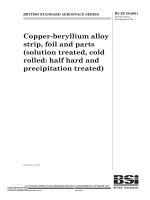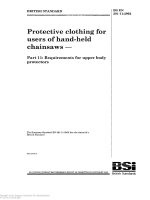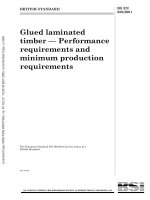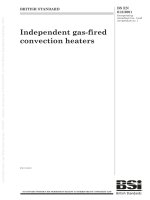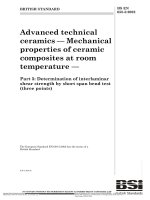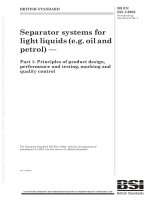Bsi bs en 61518 2001 (2002)
Bạn đang xem bản rút gọn của tài liệu. Xem và tải ngay bản đầy đủ của tài liệu tại đây (502.5 KB, 18 trang )
BRITISH STANDARD
BS EN
61518:2001
IEC 61518:2001
Incorporating
Corrigendum No. 1
Mating dimensions
between differential
pressure (type)
measuring instruments
and flanged-on shut-off
devices up to 413 bar
(41,3 MPa)
The European Standard EN 61518:2001 has the status of a
British Standard
ICS 17.100
NO COPYING WITHOUT BSI PERMISSION EXCEPT AS PERMITTED BY COPYRIGHT LAW
BS EN 61518:2001
National foreword
This British Standard is the official English language version of
EN 61518:2001, including Corrigendum February 2002. It is identical with
IEC 61518:2001.
The UK participation in its preparation was entrusted by Technical Committee
GEL/65, Measurement and control, to Subcommittee GEL/65/2, Elements of
systems, which has the responsibility to:
—
aid enquirers to understand the text;
—
present to the responsible international/European committee any
enquiries on the interpretation, or proposals for change, and keep the
UK interests informed;
—
monitor related international and European developments and
promulgate them in the UK.
A list of organizations represented on this subcommittee can be obtained on
request to its secretary.
From 1 January 1997, all IEC publications have the number 60000 added to
the old number. For instance, IEC 27-1 has been renumbered as IEC 60027-1.
For a period of time during the change over from one numbering system to the
other, publications may contain identifiers from both systems.
Cross-references
The British Standards which implement international or European
publications may be found in the BSI Catalogue under the section entitled
“International Standards Correspondence Index”, or by using the “Search”
facility of the BSI Electronic Catalogue or of British Standards Online.
This publication does not purport to include all the necessary provisions of a
contract. Users are responsible for its correct application.
Compliance with a British Standard does not of itself confer immunity
from legal obligations.
Summary of pages
This document comprises a front cover, an inside front cover, the EN title page,
pages 2 to 14, an inside back cover and a back cover.
This British Standard, having
been prepared under the
direction of the
Electrotechnical Sector
Committee, was published
under the authority of the
Standards Committee and
comes into effect on
15 June 2001
The BSI copyright date displayed in this document indicates when the
document was last issued.
Amendments issued since publication
Amd. No.
Date
13830
28 June 2002 Change to EN foreword and Figure 2
Corrigendum
© BSI 28 June 2002
ISBN 0 580 37581 1
Comments
EN 61518
EUROPEAN STANDARD
NORME EUROPÉENNE
EUROPÄISCHE NORM
March 2001
ICS 23.060
Incorporating corrigendum February 2002
English version
Mating dimensions between differential pressure (type)
measuring instruments and flanged-on shut-off devices
up to 413 bar (41,3 MPa)
(IEC 61518:2001)
Dimensions des raccords entre
les instruments de mesure à différentiel
de pression et les dispositifs d'arrêt sur
bride allant jusqu'à 413 bar (41,3 MPa)
(CEI 61518:2001)
Anschlussmaße zwischen WirkdruckMessgeräten und angeflanschten
Absperrorgangen bis 413 bar (41,3 MPa)
(IEC 61518:2001)
This European Standard was approved by CENELEC on 2001-01-01. CENELEC members are bound
to comply with the CEN/CENELEC Internal Regulations which stipulate the conditions for giving this
European Standard the status of a national standard without any alteration.
Up-to-date lists and bibliographical references concerning such national standards may be obtained on
application to the Central Secretariat or to any CENELEC member.
This European Standard exists in three official versions (English, French, German). A version in any other
language made by translation under the responsibility of a CENELEC member into its own language and
notified to the Central Secretariat has the same status as the official versions.
CENELEC members are the national electrotechnical committees of Austria, Belgium, Czech Republic,
Denmark, Finland, France, Germany, Greece, Iceland, Ireland, Italy, Luxembourg, Netherlands, Norway,
Portugal, Spain, Sweden, Switzerland and United Kingdom.
CENELEC
European Committee for Electrotechnical Standardization
Comité Européen de Normalisation Electrotechnique
Europäisches Komitee für Elektrotechnische Normung
Central Secretariat: rue de Stassart 35, B - 1050 Brussels
© 2001 CENELEC - All rights of exploitation in any form and by any means reserved worldwide for CENELEC members.
Ref. No. EN 61518:2001 E
Page 2 6 NE1512:8100
EN 61518:2001
-2-
Foreword
The text of document 65B/415/FDIS, future edition 1 of IEC 61518, prepared by SC 65B, Devices, of
IEC TC 65, Industrial-process measurement and control, was submitted to the IEC-CENELEC
parallel vote and was approved by CENELEC as EN 61518 on 2001-01-01.
The following dates were fixed:
– latest date by which the EN has to be implemented
at national level by publication of an identical
national standard or by endorsement
(dop)
2002-06-01
– latest date by which the national standards conflicting
with the EN have to be withdrawn
(dow)
2004-01-01
Annexes designated "normative" are part of the body of the standard.
In this standard, annex ZA is normative.
Annex ZA has been added by CENELEC.
__________
Endorsement notice
The text of the International Standard IEC 61518:2001 was approved by CENELEC as a European
Standard without any modification.
__________
Page 3
EN 61518:2001
CONTENTS
INTRODUCTION .................................................................................................................... 4
1
Scope .............................................................................................................................. 5
2
Normative references ....................................................................................................... 5
3
Dimensions ...................................................................................................................... 6
4
3.1 Connection dimensions at the differential pressure (type) instrument ....................... 6
3.2 Connection dimensions at the shut-off device .......................................................... 6
3.3 Seal rings ............................................................................................................... 6
3.4 Flange connection (see figures 4 and 5) .................................................................. 8
Installation ....................................................................................................................... 8
5
Material for the bolts ........................................................................................................ 8
6
Marking............................................................................................................................ 9
Figure 1 – Connection to the differential pressure (type) measuring device – Dimensions ........ 9
Figure 2 – Connection of a shut-off device type A (with spigot) – Dimensions .........................10
Figure 3 – Connection of a shut-off device type B (without spigot) – Dimensions ....................11
Figure 4 – Assembly drawing with shut-off device type A (with spigot) ....................................12
Figure 5 – Assembly drawing with shut-off device type B (without spigot) ...............................13
Table 1 – Specifications applicable to flat rings – Manifolds with extended spigot .................... 7
Table 2 – Specifications applicable to flat rings – Manifolds without extended spigot ............... 7
Annex ZA (normative) Normative references to international publications with their
corresponding European publications ....................................................................................14
Page 4
EN 61518:2001
INTRODUCTION
In a process, many shut-off devices (manifolds) are flanged direct on to the differential
pressure (type) measuring instrument (instrument).
Very often, however, the shut-off device and the measuring device are supplied by different
manufacturers. It is, therefore, essential to have the mating dimensions properly defined. In the
process industry, leakages must be avoided. In some plants, especially in processes involving
flammable or toxic gases, such a leakage can lead to risks to the plant, to its installations, to
the environment, and last, but not least, to personal safety of human beings.
In view of accidents reported from various locations, where the accident was caused by
leakage between the instrument and the manifold, it was found necessary to standardize the
mating dimensions, with its tolerances, for this combination.
Page 5
EN 61518:2001
MATING DIMENSIONS BETWEEN DIFFERENTIAL
PRESSURE (TYPE) MEASURING INSTRUMENTS AND
FLANGED-ON SHUT-OFF DEVICES UP TO 413 bar (41,3 MPa)
1
Scope
This International Standard is applicable to differential pressure (type) measuring instruments
(instrument) with a shut-off device (manifold) directly bolted on to them.
This standard specifies mating dimensions and tolerances, threads, bolts, and gaskets for a
maximum allowable working pressure of 41,3 MPa (413 bar) at 38 °C.
This standard does not apply to assemblies that provide additional sealing elements (adapters)
between the instrument and the manifold.
Where the possibility exists, shut-off devices shall be mounted on either side of the instrument,
and all connections shall then meet this standard.
Elements, such as flanged coupling joints, may apply this standard or parts thereof to increase
standardization at the discretion of the supplier and the end-user.
This standard is only valid for instrument and manifold flanges manufactured from a metallic
2
material with yield strength equal to, or larger than, 190 N/mm .
2
Normative references
The following normative documents contain provisions which, through reference in this text,
constitute provisions of this International Standard. For dated references, subsequent
amendments to, or revisions of, any of these publications do not apply. However, parties to
agreements based on this International Standard are encouraged to investigate the possibility
of applying the most recent editions of the normative documents indicated below. For undated
references, the latest edition of the normative document referred to applies. Members of IEC
and ISO maintain registers of currently valid International Standards.
ISO 48:1994, Rubber, vulcanized or thermoplastic – Determination of hardness (hardness
between 10 IRHD and 100 IRHD)
ISO 898-1:1999, Mechanical properties of fasteners made of carbon steel and alloy steel –
Part 1: Bolts, screws and studs
ISO 1629:1995, Rubber and latices – Nomenclature
ISO 3506 (all parts), Mechanical properties of corrosion-resistant stainless-steel fasteners
Page 6
EN 61518:2001
ISO 3601-1:1988, Fluid systems – Sealing devices – O-rings – Part 1: Inside diameters, crosssections, tolerances and size identification code
ISO 3601-3:1987, Fluid systems – Sealing devices – O-rings – Part 3: Quality acceptance
criteria
ASME B18.3.1M:1986 (R1993), Screws, socket head cap (metric series)
ASME B18.2.1:1996, Square and Hex Bolts and Screws Inch Series
ASTM A193:1999, Specification for alloy steel and stainless steel bolting materials for hightemperature service
ASTM A449:1993, Specification for quenched and tempered steel bolts and studs
3
Dimensions
Dimensions in figures and tables are in millimetres, except where stated otherwise.
Leak-tight connection between the differential (type) measuring instrument and the flanged
instrument manifold depends upon the conformance to the dimensions and the tolerances.
3.1
Connection dimensions at the differential pressure (type) instrument
See figure 1.
3.2
Connection dimensions at the shut-off device
Two designs for the manifold facings are recommended:
–
Type A: design with an extended spigot (see figure 2);
–
Type B: design without an extended spigot (see figure 3).
NOTE Type B design may also be suitable for differential pressure (type) transmitters, where the connecting
dimensions are not in accordance with this standard. The user is responsible for ensuring compatibility for transmitters with different dimensions.
3.3
Seal rings
The specifications for the flat ring are those of tables 1 and 2.
The O-rings are in accordance with the ISO standards quoted.
Materials and temperature limits for the flat rings and the O-ring are for reference only. It is the
responsibility of the user to ensure compatibility between the selected gasket ring material and
the process requirements, such as pressure, temperature, and chemical compatibility.
Page 7
EN 61518:2001
3.3.1
Seals for manifold design, with extended spigot – type A (see figure 2)
3.3.1.1
Flat rings
Table 1 – Specifications applicable to flat rings – Manifolds with extended spigot
Material
PTFE
Graphite
98 % graphite, density
Composition:
Virgin PTFE
1,6 - 00 ,,11 g/cm 3
Dimensions:
Outside diameter
24,0
0,0
- 0 ,1
25,1
0,0
- 0 ,1
Inside diameter
17,7
+0,1
0,0
18,0
+0,1
0,0
Thickness
2,7
Temperature limits:
+0,1
0,0
–10 °C to +80 °C
2,9
+0,2
- 0,1
–40 °C to 120 °C
(see note)
NOTE The manifold can be rated in accordance with the piping standards. The temperature limits given are based
on the limits applicable to the transmitter.
3.3.1.2
O-Ring
Dimensions:
d1 = 20, d2 = 2,65 (according to ISO 3601-1)
Material FPM:
according to ISO 1629
IRHD hardness: 90, according to ISO 48
Quality mark:
3.3.2
“S” according to ISO 3601-3
Seals for manifold design, without extended spigot – type B (see figure 3):
3.3.2.1
Flat rings
Table 2 – Specifications applicable to flat rings – Manifolds without extended spigot
Material
PTFE
Graphite
98 % graphite, density
Composition:
Virgin PTFE
1,6 0 ,1 g/cm 3
- 0 ,1
Dimensions:
Outside diameter
25,4 0,0
Inside diameter
20,0
Thickness
2,7
Temperature limits:
- 0 ,1
+0,1
0,0
+0,1
0,0
–10 °C to +80 °C
25,4 0,0
- 0 ,1
19,9
2,9
+0,1
0,0
+0,2
- 0,1
–40 °C to +120 °C
(see note)
NOTE The manifold can be rated in accordance with the piping standards. The given temperature limits are based
on the limits applicable for the transmitter.
Page 8
EN 61518:2001
3.3.2.2
O-Ring
No suitable ISO-standardized O-ring is available for the manifold without the spigot. It is the
user’s responsibility to apply O-rings according to a local standard.
3.4
Flange connection (see figures 4 and 5)
Flange connections, as described, shall only be used within the defined limits for pressure and
temperature of the instrument and manifold assembly.
4
Installation
Before mounting the instrument onto the manifold, it is necessary to check whether mating
dimensions and alignment of the mating faces of the flanges of the instrument are within the
requirements of this standard.
In an area of 28 mm around each process port, all surfaces shall be clean and without damage.
After the sealing rings have been installed between the manifold and the instrument, care
should be taken to tighten all screws at the connection evenly.
For PTFE or graphite seals, it is unavoidable that some of the gasket material creeps between
the metallic surfaces. After tightening of the bolts, the gap between the metallic surfaces of the
flanged manifold and the instruments shall be less than 0,2 mm. The thread engagement shall
be at least 0,8 times the thread diameter.
The required bolt length L should be stated as shown below (flange thickness b):
a) For blind threaded transmitters:
–
L min. = b + 9 mm
–
L max. = b + 14 mm;
b) For through threaded transmitters:
–
5
L min. = b + 9 mm.
Material for the bolts
The material for the bolts shall be chosen from the following materials, which are minimum
material requirements.
–
Medium-carbon steel, type 1, or low-carbon steel, type 2, according to ASTM A449.
–
Carbon steel, quenched and tempered, Class 8.8, according to ISO 898-1.
–
Austenitic steel, carbide solution treated and strain-hardened, according to ASTM A193,
Group B8, Class 2.
–
Austenitic steel, extra strain-hardened, according to ISO 3506, Group A2 or A4, Class 70.
Marking on the top of the bolts shall indicate conformance with the applicable standard.
Page 9
EN 61518:2001
6
Marking
Both the transmitter and the manifold, with the interface constructed to this standard, shall
have a permanent mark “IEC” on the outside, which shall be visible after installation. The minimum letter height is 5 mm.
Ỉ28
a)
20,65 ± 0,1
0,1
+0,5
54 ± 0,3
2,5 0
³15
b)
7/16’’ UNF ´ 20
41,3 ± 0,2
Ỉ18,5 0
+0,3
Ra 1,6
0,2
Common tolerance zero
IEC 2592/2000
a)
Thread for optional plug/vent screw connection to be according to the manufacturer's standard.
b)
In case the measuring device has threaded through holes, instead of threaded blind holes, the specified lengths
of such threads shall be 0,8 ´ thread diameter as a minimum.
NOTE
Not to scale.
Figure 1 – Connection to the differential pressure (type) measuring device – Dimensions
Page 10
EN 61518:2001
a)
+0,2
0
R0,4 max.
0,3 ´ 45°
2,4 0
–0,3
1,8 +0,1
0
–0,1
Ỉ18 0
Ỉ25,2 0
–0,1
Detail X
20,65 ± 0,1
–0,2
–0,1
41,3 ± 0,2
b)
54 ± 0,1
11,8
Insert (spigot),
Ra 6,3
0,2
b
X
Ra 1,6
Groove for seal ring
IEC 2593/2000
a)
b)
Flange thickness b :
–
full flange design: minimum 10 mm
–
split flange design with 2 kidney type flanges: minimum 14 mm
Construction of insert to supplier's standard. May also be integral with the flange body.
NOTE
Not to scale.
Figure 2 – Connection of a shut-off device type A (with spigot) – Dimensions
I
Page 11
EN 61518:2001
a)
+0,2
0
54 ± 0,1
0
19,9 –0,1
0
25,5 –0,1
Detail X
41,3 ± 0,2
–0,2
20,65 ± 0,1
11,8
Ra 6,3
0,2
b
R0,4 max.
2,0 +0,1
–0,1
0
X
Ra 1,6
Groove for gasket to have square edges
IEC 2594/2000
a) Flange thickness b :
–
full flange design: minimum 10 mm
–
split flange design with 2 kidney type flanges: minimum 14 mm
NOTE
Not to scale.
Figure 3 – Connection of a shut-off device type B (without spigot) – Dimensions
B ©SI 1002-60
Page 12
EN 61518:2001
Transmitter flange
Manifold block
Flat gasket or O-ring
Bolts 7/16˝ – 20 UNF (ANSI B 18.2.1)
or socket head bolts (ANSI B 18.3.1)
IEC 2595/2000
NOTE
Not to scale.
Figure 4 – Assembly drawing with shut-off device type A (with spigot)
B ©SI 1002-60
Page 13
EN 61518:2001
Transmitter flange
Manifold block
Flat gasket or O-ring
Bolts 7/16˝ – 20 UNF (ANSI B 18.2.1)
or socket head bolts (ANSI B 18.3.1)
IEC 2596/2000
NOTE
Not to scale.
Figure 5 – Assembly drawing with shut-off device type B (without spigot)
___________
B ©SI 1002-60
Page 14
--3
EN 61518:2001
E6 N1512:8100
Annex ZA
(normative)
Normative references to international publications
with their corresponding European publications
This European Standard incorporates by dated or undated reference, provisions from other
publications. These normative references are cited at the appropriate places in the text and the
publications are listed hereafter. For dated references, subsequent amendments to or revisions of
any of these publications apply to this European Standard only when incorporated in it by
amendment or revision. For undated references the latest edition of the publication referred to
applies (including amendments).
NOTE When an international publication has been modified by common modifications, indicated by (mod), the relevant
EN/HD applies.
Publication
Year
Title
EN/HD
Year
ISO 48
1994
Rubber, vulcanized or thermoplastic
Determination of hardness (hardness
between 10 IRHD and 100 IRHD)
-
-
ISO 898-1
1999
Mechanical properties of fasteners made
of carbon steel and alloy steel
Part 1: Bolts, screws and studs
EN ISO 898-1
1999
ISO 1629
1995
Rubber and latices - Nomenclature
-
-
ISO 3506
Series Mechanical properties of corrosionresistant stainless-steel fasteners
EN ISO 3506
Series
ISO 3601-1
1988
Fluid systems - Sealing devices - O-rings
Part 1: Inside diameters, cross-sections,
tolerances and size identification code
-
-
ISO 3601-3
1987
Part 3: Quality acceptance criteria
-
-
ASME B18.3.1M
1986
Screws, socket head cap (metric series)
-
-
ASME B18.2.1
1996
Square and Hex Bolts and Screws Inch
Series
-
-
ASTM A193
1999
Specification for alloy steel and stainless
steel bolting materials for hightemperature service
-
-
ASTM A449
1993
Specification for quenched and tempered
steel bolts and studs
-
-
BS EN
61518:2001
IEC 61518:2001
BSI — British Standards Institution
BSI is the independent national body responsible for preparing
British Standards. It presents the UK view on standards in Europe and at the
international level. It is incorporated by Royal Charter.
Revisions
British Standards are updated by amendment or revision. Users of
British Standards should make sure that they possess the latest amendments or
editions.
It is the constant aim of BSI to improve the quality of our products and services.
We would be grateful if anyone finding an inaccuracy or ambiguity while using
this British Standard would inform the Secretary of the technical committee
responsible, the identity of which can be found on the inside front cover.
Tel: +44 (0)20 8996 9000. Fax: +44 (0)20 8996 7400.
BSI offers members an individual updating service called PLUS which ensures
that subscribers automatically receive the latest editions of standards.
Buying standards
Orders for all BSI, international and foreign standards publications should be
addressed to Customer Services. Tel: +44 (0)20 8996 9001.
Fax: +44 (0)20 8996 7001. Email: Standards are also
available from the BSI website at .
In response to orders for international standards, it is BSI policy to supply the
BSI implementation of those that have been published as British Standards,
unless otherwise requested.
Information on standards
BSI provides a wide range of information on national, European and
international standards through its Library and its Technical Help to Exporters
Service. Various BSI electronic information services are also available which give
details on all its products and services. Contact the Information Centre.
Tel: +44 (0)20 8996 7111. Fax: +44 (0)20 8996 7048. Email:
Subscribing members of BSI are kept up to date with standards developments
and receive substantial discounts on the purchase price of standards. For details
of these and other benefits contact Membership Administration.
Tel: +44 (0)20 8996 7002. Fax: +44 (0)20 8996 7001.
Email:
Information regarding online access to British Standards via British Standards
Online can be found at />Further information about BSI is available on the BSI website at
.
Copyright
Copyright subsists in all BSI publications. BSI also holds the copyright, in the
UK, of the publications of the international standardization bodies. Except as
permitted under the Copyright, Designs and Patents Act 1988 no extract may be
reproduced, stored in a retrieval system or transmitted in any form or by any
means – electronic, photocopying, recording or otherwise – without prior written
permission from BSI.
BSI
389 Chiswick High Road
London
W4 4AL
This does not preclude the free use, in the course of implementing the standard,
of necessary details such as symbols, and size, type or grade designations. If these
details are to be used for any other purpose than implementation then the prior
written permission of BSI must be obtained.
Details and advice can be obtained from the Copyright & Licensing Manager.
Tel: +44 (0)20 8996 7070. Fax: +44 (0)20 8996 7553.
Email:
